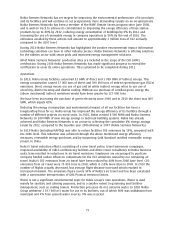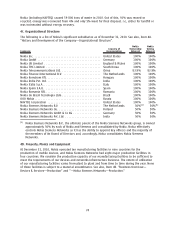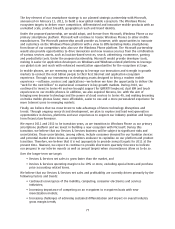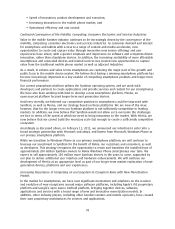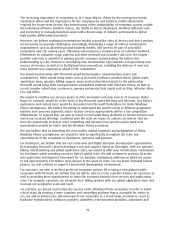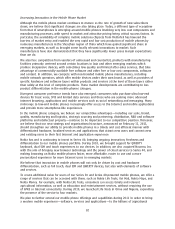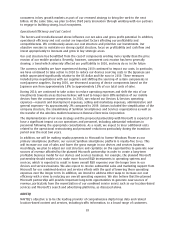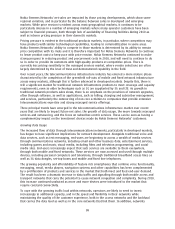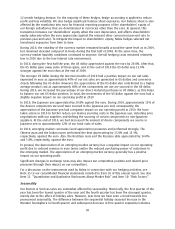Nokia 2010 Annual Report Download - page 84
Download and view the complete annual report
Please find page 84 of the 2010 Nokia annual report below. You can navigate through the pages in the report by either clicking on the pages listed below, or by using the keyword search tool below to find specific information within the annual report.consumers in key growth markets as part of our renewed strategy to bring the web to the next
billion. At the same time, we plan to drive third party innovation through working with our partners
to engage in building strong, local ecosystems.
Operational Efficiency and Cost Control
The factors and trends discussed above influence our net sales and gross profit potential. In addition,
operational efficiency and cost control are important factors affecting our profitability and
competitiveness. We continuously assess our cost structure and prioritize our investments. Our
objective remains to maintain our strong capital structure, focus on profitability and cash flow and
invest appropriately to innovate and grow in key strategic areas.
Our cost structure has benefitted from the cost of components eroding more rapidly than the price
erosion of our mobile products. Recently, however, component cost erosion has been generally
slowing, a trend which adversely affected our profitability in 2010, and may do so in the future.
The currency volatility we have experienced during 2010 continued to impact our costs. In particular,
we have continued to take action in 2010 to reduce our devices sourcing costs in the Japanese yen
which appreciated significantly relative to the US dollar and the euro in 2010. These measures
included price negotiations with our suppliers and shifting the sourcing of certain components to
nonJapanese suppliers. During 2010, we decreased sourcing of device components based on the
Japanese yen from approximately 18% to approximately 12% of our total costs of sales.
During 2010, we continued to take action to reduce operating expenses and shift the mix of our
investments towards areas that we believe will lead to longerterm differentiation of our mobile
devices from the consumer perspective. In 2010, we reduced our Devices & Services operating
expenses—research and development expenses, selling and marketing expenses, administrative and
general expenses—by approximately 2% compared to 2009. Actions included the simplification of the
company structure, the streamlining of Symbian Smartphones and Services organizations as well as
the transfer of the wireless modem business to Renesas Electronics Corporation.
The implementation of our new strategy and the proposed partnership with Microsoft is expected to
have a significant impact on our operations and personnel, including substantial reductions in
personnel following the appropriate consultations. As a result, we expect to incur additional costs
related to the operational restructuring and personnel reductions particularly during the transition
period over the next two years.
In addition, we will be making royalty payments to Microsoft to license Windows Phone as our
primary smartphone platform; our current Symbian smartphone platform is royaltyfree to us. This
will increase our cost of sales and lower the gross margin in our devices and services business.
Accordingly, we plan to adjust our cost structure and capitalize on the opportunities to generate new
sources of revenue afforded by the planned Microsoft partnership in order to create a longterm
profitable business model for our devices and services business. For example, the planned Microsoft
partnership should enable us to make more focused R&D investments in operating systems and
services, which is expected to result in lower overall R&D expenses over the longer term in our
devices and services business. We also expect to receive substantial sales and marketing support from
Microsoft for our combined devices and services efforts with the goal of lowering those operating
expenses over the longer term. In addition, we intend to address other ways to increase our cost
efficiency with a view to reducing our overall operating expenses. We also believe that the planned
Microsoft partnership will provide important longterm opportunities to generate new sources of
revenue, particularly from the monetization of our combined service assets such as our locationbased
services and Microsoft’s search and advertising platforms, as discussed above.
NAVTEQ
NAVTEQ’s objective is to be the leading provider of comprehensive digital map data and related
locationbased content and services, including traffic information, to a broad range of customers.
83


